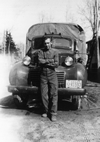17. Quarry
AT THE QUARRY during those years, Serafino was in his prime. He had steady work every day. Even during winter. His was a predictable yet thrilling routine. Operating a tractor, he dug away nine to ten feet of black dirt before hitting solid rock. He and the other men then poured water into the excavated hole and maneuvered an enormous electric drill into place to bore 60 feet down into the bedrock for the placement of dynamite. Once the drill had been chiseled down into the earth, the men inserted a tube to suck the water back out of the hole. Upon removing the drill and tube from the deep cavity, the men lowered the dynamite into the dark, dry place. And as soon as they lit the fuse, they got the hell out of the way. When the kids on Lehigh Row heard the whistle scream, they knew their dads were about to blow up something that would later become cement. Each blast left behind a 60-foot cliff overlooking a hole in the ground with rocks strewn everywhere. Serafino drilled five or six holes a day and carted away the rocky riches in his tractor. He never learned how to drive a car, but he was the master of his tractor in the quarry.
He spread the word back to Farindola. Others followed, beginning with his brothers, Antonio and Gaetano; his sister Mariacarma; and his brother-in-law Francesco Baccanale. News about the jobs traveled fast, and the Di Gregorio home of 30 Lehigh Row became a settlement house for men from Farindola and other nearby villages. Several of the men lived for months with the Di Gregorios as boarders until they found other places of their own on Lehigh Row, leaving room for further newcomers at 30 Lehigh Row. That helps to explain how Lehigh Row became the first American home for a long line of immigrant families from one small corner of Abruzzi: the Ammazzalorsos, Barbarossas, Cardarellis, Cirones, Colantonis, Di Luccos, Di Marcos, Magnanis, Maranos, Marrones, Napoletanos, Nardicchios, Puccellas, Scalabronis, and Tatones as well as the Baccanales and Di Gregorios. Serafino begged his aging mother to come join them all on Lehigh Row, but she was already too frail to endure the arduous journey down from the hills.
Serafino, Maria, and the babies slept in the bedroom downstairs. The upstairs became a dorm room for the older kids and the boarders. The older girls slept on one side of the staircase. Raffaello and the boarders slept on the other.
The boarders were a cast of characters. The most memorable were Uncle Tony, who made and played violins and mandolins; Uncle Gaetano, who couldn’t find enough pretty women in Iowa and so moved back to Italy; Uncle Joe, who wasn’t really related to anyone; and Red Pete, a gambler and a fighter who ran with a rough crowd. Red Pete had earned his nickname for having red hair and green eyes and for being suspiciously pale.
There was one big piss pot upstairs for everybody. That way, nobody had to venture out into the freezing cold in the middle of the night during winter or any other season to use the outhouse. Instead, everybody used the piss pot. It was made of white enamel, shaped like a bucket, and equipped with a lid. Everybody in the house did everything in that pot. Each morning, somebody had to carry the brimming pot down the stairs and dump it into the outhouse. Nobody ever wanted that job, but everybody took turns doing it. After all, everybody was in that pot together.
